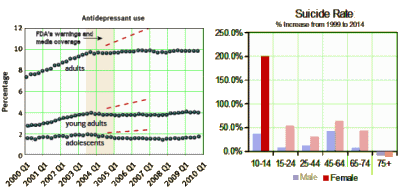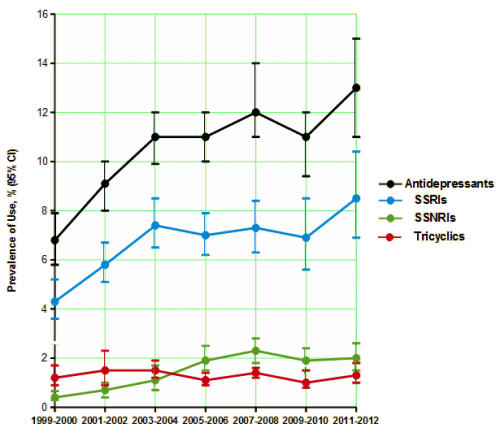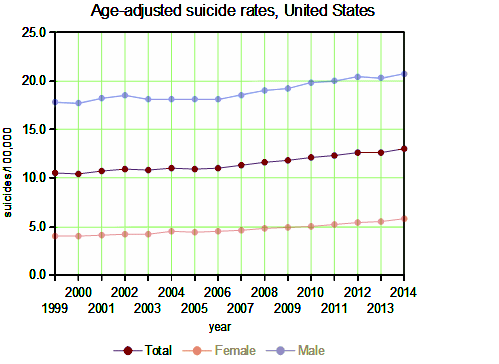 All Aboard! As the ripples from the recently released suicide figures spread across the water, the usual suspects are being lined up to take the blame: not enough antidepressants, too many antidepressants, biomedical psychiatry, the American Psychiatric Association, the FDA’s Black Box Warning, Tom Insel’s NIMH, Managed Care, the Pharmaceutical Industry, Hospital Corporations, things like 911 or the Iraq War, the great recession, Republicans, Democrats, the NRA. And the non-psychiatric community who have been reimbursed to take over ongoing mental health care [along with their guilds] earned their right to be added to the list: Psychologists, Social Workers, LPCs, etc. Nobody gets off the hook here. There’s room on this train for every one of us. All Aboard!
All Aboard! As the ripples from the recently released suicide figures spread across the water, the usual suspects are being lined up to take the blame: not enough antidepressants, too many antidepressants, biomedical psychiatry, the American Psychiatric Association, the FDA’s Black Box Warning, Tom Insel’s NIMH, Managed Care, the Pharmaceutical Industry, Hospital Corporations, things like 911 or the Iraq War, the great recession, Republicans, Democrats, the NRA. And the non-psychiatric community who have been reimbursed to take over ongoing mental health care [along with their guilds] earned their right to be added to the list: Psychologists, Social Workers, LPCs, etc. Nobody gets off the hook here. There’s room on this train for every one of us. All Aboard!by Kantor ED, Rehm CD, Haas JS, Chan AT, and Giovannucci ELJAMA. 2015 314[17]:1818-1831.
hat tip to Justin Karter…
and for review, the recent suicide statistics with equivalent abscissa scaling…
National Center for Health StatisticsCenters for Disease Control and Preventionby Sally C. Curtin, Margaret Warner, and Holly HedegaardNCHS Data Brief No. 241, April 2016
It’s obvious that there’s no reason to hypothesize that there’s an antidepressant deficiency upon the land. And as for the APA President’s predictable [and irresponsible] quip:
"Now, the other thing that we were anticipating with some dread was the aftermath of the black box on antidepressants," says Oquendo, referring to a warning label that in 2004 the Food and Drug Administration required for commonly prescribed antidepressants. The label says that in people under age 26, the medications can actually increase the risk of suicidal thoughts and actions. Research has suggested that the warning scared doctors away from prescribing antidepressants to people of all ages. "And some of the increment in suicide deaths in the younger populations is potentially linked to an understandable reluctance by physicians who see these youngsters to prescribe antidepressants, even when they’re aware that the individual is suffering from depression," says Oquendo. Research has shown that the benefits of prescribing antidepressants to mentally ill children tend to outweigh the risk of suicidal tendencies…
All the Black Box Warning did was slow the acceleration of antidepressant use in kids, unlikely to have had the kind of impact shown, for example, in teenaged girls. The graph on the left is from Lu et al with the recent suicide figures on the right:

My takeaway from these suicide figures is that it’s a solid indictment of our entire mental health system, not of any particular element. The tragedy is that we actually know how to deliver the care at a much more effective level. We’ve known for a long time. But we’re too busy haggling with each other to do it…


You are absolutely right, it is a multi-dimensional process playing a role in so many different fashions, you could probably write 10 posts about this and all of them would make sense when complete.
But, at the end of the day, it doesn’t change the fact that more people are killing themselves in this country. And that statistic should bother every single psychiatrist, much less any other mental health care provider.
All we can do is control as best the things that we control, and that starts with ourselves. And if we don’t look at this issue in a multidimensional way, and just keep throwing drugs at it as psychiatrists, we are failing the public!
So, doctors do what they do, other Mental Health Care Professionals do what they do in their field, the patients do what they do in controlling their psycho socio-economic factors, and most importantly , we turn to people who are leaders, people of influence, and people who have inherent power in the community and in the country to help and support, not just look for a quick and easy fix, the convenient and short-term answer, and worst just what’s popular!
I know it’s not simple, but you start with the simple things, and you make sure people are responsible, accountable, and most important they give a damn!
And in our profession, I think at least 50% of our colleagues don’t give a damn, they don’t give a crap, they just look at their wallets and purses and literally say that stupid line from the movie, “show me the money!”
It’s just so pathetic what goes on in Psychiatry these days…
Columbia again. There must be something huckster-ogenic in the West Upper Manhattan water supply.
Disturbing piece:
http://www.psychiatrictimes.com/depression/federal-government-ignores-treatment-needs-americans-serious-mental-illness/page/0/1
Doctors, heal thyselves, organized psychiatry has a case of collective ADHD. Intent on labelling and doing a half-assed job of treating three hundred diagnoses instead of doing a good job and focused effort on the big fifteen.
James O’Brien’s “big fifteen” must correspond pretty much to what I have called the A-list. He is absolutely right in saying that is where psychiatrists’ efforts should be concentrated. Could you maybe please spell out for us your full list? Thanks.
This is thinking out loud and based on clinical experience, but here are my thoughts. Pretty much the Feighner list minus homosexuality and organic disorder which is too undefined. That gets it down to 12. Might have to dump hysteria or tighten it up or make it part of Axis 2.
I’d add dementia with subtype modifiers as well as delirium in the place of organic disorder. For mental retardation, I’d split this into low iQ based on inability vs. lack of education. It’s like the difference between dystrophy and atrophy and it amazes me that this hasn’t been distinguished in 35 years of DSM since these are qualitatively much different and so is the prognosis.
I’d distinguish melancholic depression from other types of depression for all the reasons that you’ve described in your articles and comments here.
For the personality disorders outside of antisocial, I’d probably go along with a Millon type dimensional analysis. With the possible exception of severe borderline which probably is categorical. I’d acknowledge ADHD but with much stricter criteria than the present. Probably need a category for dysfunctional paraphilias too.
Now where’s my grant money to develop this?
oh and PTSD, and autism, too, both tightened up..
I like Organ·ic Brain Syndrome [Delerium and Dementia] for his Cerebral Diseases. «diseases of “the Organ“».
I’d replace his Major Psychoses with Psychiatric Diseases which would include Schizophrenia, Manic Depressive Insanity, Melancholia, some OCD and GAD [the severe kinds present from birth], Autism?. Any of the syndromes we think of in a Disease Model way.
[here come my roots] I would classify Personality Disorders along multiple axes, the most important being on the spectra of Attachment and Interpersonal patterns. Enduring Personality Traits would be described individually…
And I would put PTSD over to the side with axes of it’s own.
Symptomatic illnesses [the old neuroses] would be described in a narrative style without any “nouns” or enduring labels. The same with Addiction/Substance Abuse…
I can summarize it even easier: mood disorder NOS, anxiety disorder NOS, cognitive disorder NOS, organic mood / thought / anxiety NOS, ADD, PTSD, substance abuse / dependence / withdrawal syndromes, Personality disorder NOS, and psychological distress in general?
At the end of the day, we don’t know what the hell we’re treating over half the time at least the first couple months they’re in the office, because it’s a combination of axis 1, Substance abuse, Axis 2, medical issues, psychosocial stressors, and where the hell they are at the time they walk in the office, i.e. the GAF scores.
which is why we shouldn’t give up doing multiaxial assessment. It gives a better snapshot of what’s going on in the office than what the DSM-5 is claiming, which I have relabeled the Duplicitous Shit Manual.
As a shout out to Dr O’Brien, I’m always amused and enthused by your comments.
I’d get rid of the numbers in the “axes” because they imply an nonexistent hierarchy. Let’s call them Axis Psychiatric, Axis Character, Axis Medical, Axis Environmental.
Many problems are Axis Character crashing into Axis Environmental and are not really major psychiatric disorders.
Since rising suicide rates is the topic for this thread, I’d like to say: Dr. O’Brien is surely correct when he says that “many problems are Axis Character crashing into Axis Environmental.” If you want to classify these problems as “not really major psychiatric disorders” so be it. But I bet these crashes account for the majority of suicide attempts and completed suicides. And surely suicide is a major psychiatric problem.
That’s why I used the term many. They are certainly major psychological problems and obviously there is serious mood disorder overlap.
Suicide is a major problem, but, if we are to agree it is multidimensional in cause, then we have to approach treatment in a multidimensional manner.
At the end of the day, suicide is a terminal solution to temporary problems, a patient once told me that years ago, and I like the perspective.
So, to all those mental health care providers wanting people to be on pills, well, how’s that going for the public these days? And all those people who want patients to be in psych units for every time they have a suicidal thought, well, how’s that going as well? And to all those folks who think that death is the only answer to psychosocioeconomic problems, well, who’s gonna fix those issues after you are dead?
So, the status quo sucks, no argument. How do we enact change for the better? It starts with the person in the mirror. Be it patient, provider, support person, peer, colleague, friend, significant other, whoever else. Death is not an answer, it is a choice, but with no further option.
People shouldn’t be taking their lives and we shouldn’t be just reading these statistics like another news story of the week. This current election is a tip of the iceberg of this time of this culture, and it’s time people step back and really think about the course of the country. Are we really going to accept we have to choose between two deeply flawed people who will be the last people to really represent the basic tenets of America?
Really, a pathological Narcissist or an entrenched Antisocial? This is the best we’ve got, folks?
We have to restore hope and faith for the people. We can’t make 95% of the public regain sanity and order, but I’ll be damned we have to accept that 50% at best have common sense and basic understanding of right and wrong.
Cue Network, please?!
https://www.youtube.com/watch?v=rGIY5Vyj4YM
You know it, and it fits 40 years later!!!
Too bad there aren’t effective drugs for lack of emotional resiliency…oh wait I found one:
http://i2.wp.com/www.powerlineblog.com/ed-assets/2016/04/Growacet-copy.jpg?zoom=2&resize=580%2C537
Epidemiological data, as presented in this post, don’t support a link between antidepressant use and a reduction in suicide rates, and neither do clinical trials:
http://www.karger.com/Article/Abstract/442293